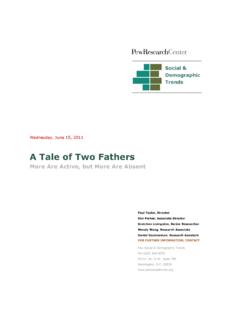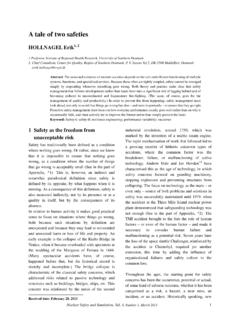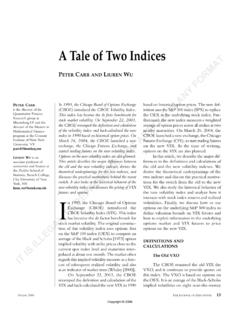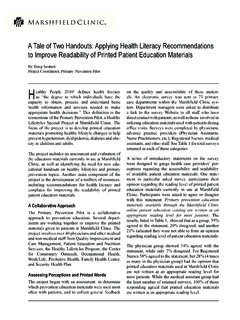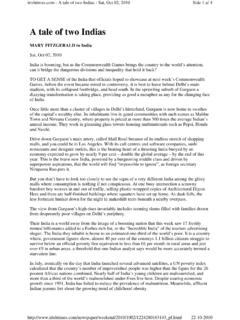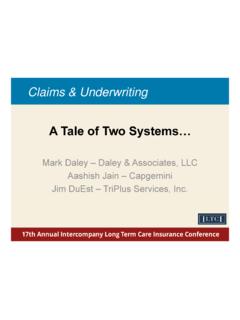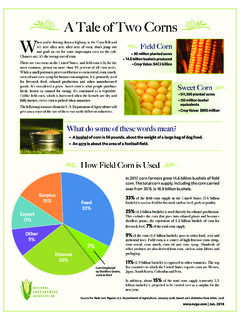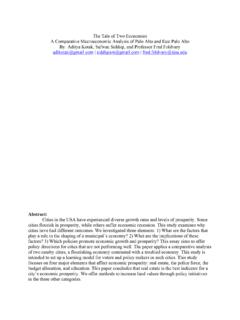Transcription of A Tale of Two Cities - Congressman Mike Quigley
1 Reinventing Tax Increment Financing A Tale of Two Cities Mike Quigley Cook County Commissioner April 2007 A Tale of Two Cities : Reinventing Tax Increment Financing April 2007 Mike Quigley Cook County Commissioner, 10th District 118 North Clark Street, Room 567 Chicago, Illinois 60602 (312) 603-4210 Fax (312) 603-3695 Staff Kimberly Walz, Chief of Staff Jason Liechty, Director of Policy Jeremy Thompson, Senior Policy Analyst Bianca Suarez, Legislative Aide Report Authors Jeremy Thompson Jason Liechty Mike Quigley Acknowledgments Laura Nelson Jennifer Koehler Bill Vaselopulos Dominick Spalla Arjun Pandya Sue Tursman Tanya Anthofer Jacqueline Leavy Travis Stein John Paul Jones Bill Abolt Alma Arias Hap Heer Kara Pennoyer Maggie Schilling Ada Varshavsky Tony Binns Joanne Worthy Sherri Farris H. Woods Bowman, DePaul University David Merriman, Loyola University Chicago John Pelissero, Loyola University Chicago Dick Simpson, University of Illinois at Chicago Rachel Weber, University of Illinois at Chicago and many others When the Neighborhood Capital Budget Group (NCBG) went out of business in February 2007, arguably the greatest voice for TIF reform in Chicago over the past two decades went quiet.
2 NCBG s unflagging grassroots-level efforts to inform and organize Chicagoans led to substantial change in how the city operates its TIF program, and it has left behind a network of neighborhood organizations, researchers and community activists knowledgeable about TIF and aggressive in their pursuit of reform. We hope this report aids them in their effort, and we hope that it will inspire even more people to join the call for change. Table of Contents Executive Summary .. i A Tale of Two I. in Cook County and Chicago ..1 II. TIF and Overlapping Taxing Entities ..6 Property Taxes in Cook County: A Brief Overview ..6 TIF and But For Question: Causing Growth or Capturing It? ..11 Literature But For Question in Chicago ..12 The Joint Review III. TIF and the Property Tax Bill ..19 The Consolidated and the Tax and the Consolidated Rate ..24 The Older the TIF, the Greater the Tax Rate TIFs Keep the Tax Rate for and the Tax Bill.
3 29 IV. Porting: How Local are TIF s Benefits? ..38 V. TIF and the Availability of Information ..41 VI. TIF and VII. Conclusion ..48 Recommendations Adjust the base every year by inflation.. 10 Analyze fiscal effects of proposed TIFs on local units of 15 Include detailed budgets and tax increment caps in all new TIF 16 Include detailed accounting of surplus increment in annual TIF reports.. 16 Include all affected local taxing entities on Joint Review Board.. 17 Require Cook County s JRB member to vote as directed by the 17 Include TIF rate and TIF tax information on property tax bills.. 34 Show the actual amount paid to TIF on property tax bills.. 34 Restrict the movement of TIF money by distance instead of 40 Limit portable money to a percentage of the originating TIF s surplus.. 40 Develop an 21st-century online TIF information portal.. 42 Abolish the CDC in favor of neighborhood-level oversight institutions.. 47 List of Figures Figure 1.
4 Growth of TIF in Chicago and suburban Cook County, 2 Figure 2. Property tax revenues lost each year to inflation by local taxing districts in Cook County. 10 Figure 3. Subarea with TIF.. 13 Figure 4. Change in property value growth rate in areas with and without TIF.. 14 Figure 5. Tax rates for City of Chicago, 2005.. 20 Figure 6. Chicago tax rates and median residential property tax bills, 1997-2005.. 21 Figure 7. Property Value in and out of the TIF Zone over the life of a single 25 Figure 8. The TIF Rate in and out of the TIF Zone over the life of a single 25 Figure 9. Property Value in and out of the TIF Zone over the life of multiple TIFs.. 27 Figure 10. The TIF Rate in and out of the TIF Zone over the life of multiple TIFs.. 28 Figure 11. A model of how TIF affects the property tax bill.. 29 Figure 12. TIF rates (in italics) and TIF taxes paid by median Chicago homeowner, 1997-2005.. 32 Figure 13. TIF taxes in the City of Chicago, 1997 and 33 Figure 14.
5 Sample tax bill for a Chicago property inside a TIF, showing no contribution to the 35 Figure 15. Proposed redesigned tax bill for a Chicago property inside a TIF, showing actual contribution to the TIF.. 36 Figure 16. Midwest, Madison/Austin and Harrison/Central TIFs, and the DePriest Elementary attendance boundary.. 39 Figure 17. Map of the Central Loop 41 Figure 18. Chicago Police Department s CLEAR Map, a potential model for an interactive TIF-mapping site.. 43 Figure 19. Pages from the website of the Community Redevelopment Agency of Los 44 List of Tables Table 1. Chicago s Tax Increment Financing program relative to other Primary Government budget categories..3 Table 2. Property Values and Tax Increments in Chicago s Midwest TIF, 8 Table 3. Property values and tax increments with inflation-adjusted base in Chicago s Midwest TIF, 9 Table 4. Tax revenues lost to inflation by taxing entities overlapping TIF districts in Cook County, 9 Table 5.
6 Tax rates in Chicago, 20 Table 6. Tax levies, tax bases and tax rates for the seven taxing districts in Chicago, 2005.. 30 Table 7. Property values in the seven Chicago taxing districts including captured incremental value, 8. Tax levies, tax bases and tax rates for the seven taxing districts in Chicago after adjustment for captured incremental property value, 2005.. 31 Table 9. TIF activities by level of geography.. 42 i Executive Summary Tax increment financing (TIF) is a mechanism that allows municipalities to earmark tax revenues from property value growth within a designated area suffering from blight a TIF district in order to finance development in that same area. TIF has become the economic development tool of choice in hundreds of municipalities throughout Illinois; it is especially popular in Cook County. In 2005 there were 373 TIF districts countywide, earning over $686 million in property tax revenue nearly matching the County s entire 2005 property tax extension of $720 million.
7 Two-thirds of the county s municipalities had at least one TIF in 2005; Chicago alone had 136. Taxpayers in Chicago paid more property taxes to TIF in 2005 $386 million than they did to Cook County. Proponents have called TIF the only game in town, implying that municipalities have no other economic development tools at their disposal. They argue that TIF allows municipalities to finance redevelopment without having to raise property taxes. TIF advocates also point to the development within a TIF district as evidence of its effectiveness, arguing that the area would have remained un- or underdeveloped but for the use of TIF. Critics of TIF call these claims into question. Municipalities, they point out, have created TIF districts in areas not suffering from blight, the most prominent example of which is Chicago s central business district.
8 Moreover, they claim that TIF does in fact raise property taxes, and not only that, but it also harms units of local government, like counties and school districts, that rely on property taxes for significant portions of their local revenues. In addition to pointing out TIF s potentially detrimental effect on local taxing entities and their taxpayers, critics have found fault with the way in which municipalities implement TIF, citing a lack of comprehensive planning, weak oversight, poor documentation, and significant barriers to public participation. The controversy over TIF, then, stems not only from its impact, but from the processes that govern it. This report looks at several of the questions surrounding TIF. Our focus is mainly on Chicago s TIF program, but we give some attention to its use in suburban Cook County, as well. We conclude that while TIF may be a useful tool for economic development, criticisms of TIF are largely well-founded.
9 Our findings include the following: Several areas of Chicago in which TIFs have been created have failed to grow any more than similar areas where TIF has not been used. In 2005, TIF districts consumed nearly 10 cents of every property tax dollar collected in Chicago and 26 percent of the City s total acreage. In 2005, Chicago s taxpayers paid four percent more in property taxes than they would have paid without TIF, a sevenfold increase from 1995. Because of how the state TIF legislation is worded, local governments in Cook County have lost nearly $700 million simply to inflation. Despite taking in over $386 million in 2005 more than Chicago s Streets and Sanitation and Transportation departments TIF is effectively excluded from the city s annual operating budget. What annual accounting does exist includes a minimum of tabular data, with no narrative component.
10 Anyone not already intimately familiar with the inner workings of TIF is Executive Summary ii likely to find it very difficult, if not impossible, to figure out where exactly hundreds of millions of TIF dollars are going. Charged with overseeing Chicago s TIF program, the Community Development Commission (CDC) exercises little actual oversight. Of 812 individual votes cast since November 2005, 808 have been yeas. None of the items that have come before the CDC since November 2005 has been voted down. If TIF really is the only game in town, then these findings are deeply troubling. Over two decades since Chicago first adopted TIF, it is time to reinvent TIF. This report makes several specific recommendations, including the following: Proposals for new TIF districts should include a study of the potential impact on all affected local governments.

